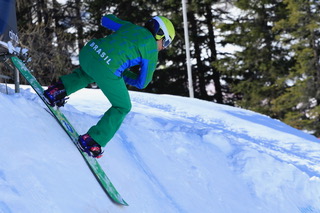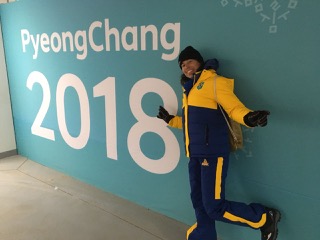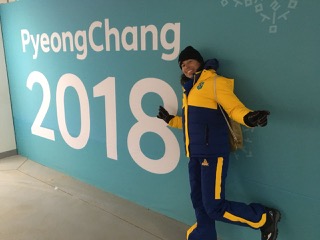The journey to the PyeongChang Olympic Games was an intense and remarkable experience. Four years of intense dedication and effort were spent maintaining high performance and evolving in all areas. Many people helped me, which was extremely important.
The 2017 Southern season was excellent. We trained in different starting sections and sbx tracks, achieved prominent podium finishes in the South American Cups, and qualified for both World Cup finals in Bariloche. Following this, I continued intense physical training in Brazil, focusing on strength, power, aerobic intervals, and technical skateboarding.
We started the Northern Olympic season in early November, beginning specific training with the Italian team, and I quickly adapted to their training pace, which was already at least two cycles ahead of me. I then participated in two more World Cup stages in France and Austria, qualifying for the finals in both. Finishing in all the first four stages of the season, within the top 15.
After that, we headed to the World Cup stage in Italy, and it was there that I suffered a serious accident on the first qualifying run, right at the end of the track, and had to be airlifted to the hospital with a severe cervical injury. Even though I was practically unable to move in the hours following the accident due to extreme neck pain, tests showed no injury. Even so, the severe impact and swelling caused my muscles to stop functioning. Of all the accidents I’ve had, I’d never felt so much pain.
Returning to Brazil, my doctor, Dr. Leonardo Metsavaht, told me I had to thank my guardian angel, as this accident could have had fatal consequences. I had to postpone my trip to Europe for three weeks and spent a month in Rio de Janeiro recovering, juggling exercise, pain, physical therapy, and mesotherapy. I missed snow training and three World Cup stages. Recovering from the injury was difficult, but by the end of the period, I was starting to do physical training and even specific skateboarding training. We finally left for Europe feeling confident, still experiencing pain, but much more controlled than at the beginning. And even though I had lost muscle mass, I knew my technique and muscle memory would help me a lot.
But on the snow wasn’t what we expected. The cold, the greater impact, strong compressions, and vibrations during descents made the pain more intense, both during and after training. Even so, we went to a World Cup in Germany, and during official training, the pain intensified with each attempt to descend the slope, and I felt very insecure. We decided not to compete.
Next stop was the Olympic Games. I knew I would face a difficult situation, with a demanding track and severe pain. I hoped that powerful pain medication could help my performance.
Arriving at the Olympic Village, the PyeongChang cold made the pain even worse every day, and I had to skip the opening ceremony. The day before the first day of official training on the Olympic Games SBX track, with much insistence from me and the coaching staff, the Brazilian delegation doctor prescribed me a powerful pain reliever. With the medication, it was the first time I felt normal, and my neck stopped bothering me for a few hours. I was able to focus on my technique and gain a little more confidence on the track.
At the end of the second day of training, when I was feeling a little more comfortable, I went for the biggest jump for the first time, thinking I was at the right speed. But there was a slight headwind that I didn’t notice, and I landed super short, with a big impact, and I injured my right knee and heel.
I was transported by ski patrol on a sled to the clinic and then taken to the hospital, where I remained for several hours for X-rays and MRIs. Although the tests revealed no fractures, I was unable to walk due to the pain in my heel and the swelling knee.
The day after my accident, in the men’s SBX competition, 11 athletes were hospitalized during the finals with serious conditions, such as cervical fractures, tibial fractures, knee ligament injuries, and so on. After this experience, many changes were made to the track for the women’s competition, which was better and had fewer accidents. Even so, six girls had already had accidents during training days, including me, who couldn’t start. It was very sad to watch the competition from the sidelines.
Returning to Chile and then Brazil, I had my knee examined, and after some differing opinions, we finally concluded that surgery wasn’t necessary.
The best surprise I had was when I arrived in Rio de Janeiro. I received a wonderful reception organized by my sister Ana, with family, friends, and neighbors, including a beautiful samba performed in my honor by the “Batuque do Martelo” group from the street where I grew up. See the attached video.
After these two serious accidents, I thank God for being healthy and walking. Not only the journey for this last Olympics, but every Olympics I have been preparing for, fours Olympic cycles, where I full dedicated myself, with ups and downs, focus, love and resilience. I’m very grateful for the support of everyone who made this journey possible and was with me throughout the process, specially Iván Fuenzalida, who gave me full support and dedication thought all these years. And to the angels and beings of light who are always by my side, protecting and giving me strength. That’s it guys, thanks again for following me and don’t forget to check out the photos and videos, there are lots of cool stuff!





